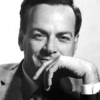Richard P. Feynman

Richard P. Feynman
Richard Phillips Feynmanwas an American theoretical physicist known for his work in the path integral formulation of quantum mechanics, the theory of quantum electrodynamics, and the physics of the superfluidity of supercooled liquid helium, as well as in particle physics for which he proposed the parton model. For his contributions to the development of quantum electrodynamics, Feynman, jointly with Julian Schwinger and Sin-Itiro Tomonaga, received the Nobel Prize in Physics in 1965...
NationalityAmerican
ProfessionPhysicist
Date of Birth11 May 1918
CountryUnited States of America
I don't know what's the matter with people: they don't learn by understanding, they learn by some other way — by rote or something. Their knowledge is so fragile!
For a successful technology, reality must take precedence over public relations, for Nature cannot be fooled.
I was born not knowing and have had only a little time to change that here and there.
We are at the very beginning of time for the human race. It is not unreasonable that we grapple with problems. But there are tens of thousands of years in the future. Our responsibility is to do what we can, learn what we can, improve the solutions, and pass them on.
The highest forms of understanding we can achieve are laughter and human compassion.
Science is like sex: sometimes something useful comes out, but that is not the reason we are doing it
I learned very early the difference between knowing the name of something and knowing something.
Study hard what interests you the most in the most undisciplined, irreverent and original manner possible.
Working out another system to replace Newton's laws took a long time because phenomena at the atomic level were quite strange. One had to lose one's common sense in order to perceive what was happening at the atomic level.
With the exception of gravitation and radioactivity, all of the phenomena known to physicists and chemists in 1911 have their ultimate explanation in the laws of quantum electrodynamics.
When I would hear the rabbi tell about some miracle such as a bush whose leaves were shaking but there wasn't any wind, I would try to fit the miracle into the real world and explain it in terms of natural phenomena.
What goes on inside a star is better understood than one might guess from the difficulty of having to look at a little dot of light through a telescope, because we can calculate what the atoms in the stars should do in most circumstances.
We seem gradually to be groping toward an understanding of the world of subatomic particles, but we really do not know how far we have yet to go in this task.
We get the exciting result that the total energy of the universe is zero. Why this should be so is one of the great mysteries - and therefore one of the important questions of physics. After all, what would be the use of studying physics if the mysteries were not the most important things to investigate?